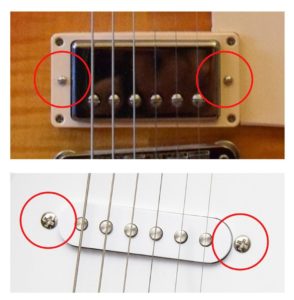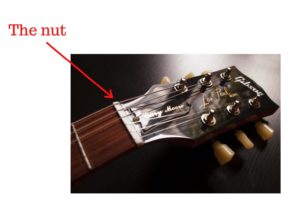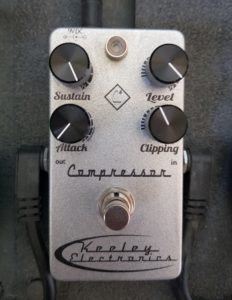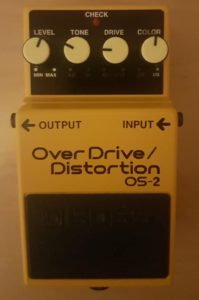What actually is sustain?
Before we jump into the 9 best ways to improve the sustain on your electric guitar, I thought it’d be a good idea to address exactly what we mean by sustain, and how it works, so you can understand the methods a bit more clearly.
Put simply, sustain refers to how long a note rings out for on your guitar. This is related to how long the strings vibrate. The longer it takes for the vibrations to disperse, the better the sustain will be.
So in order to increase the sustain, you should be doing everything you can to make the strings vibrate for longer, or try and find a way to make sure the vibrations are still detected by the pickups even when they start to slow down.
How to Increase Sustain
The best way to increase the sustain on your electric guitar, is to make your strings vibrate for longer, or help optimise the way the vibrations are detected.
You can increase the sustain on your guitar right away, for free, by increasing the gain on your amplifier, or the bass control. You should also have the tone and volume controls on your guitar on maximum, avoid having your pickups set too high, and make sure your tuner heads are tightened fully.
Other cheap ways to improve sustain, include, using thicker strings, using a bone or metal nut (instead of a plastic one) and using a thicker and harder pick.
If you’ve tried all this cheap and easy methods, then consider investing in a compression, overdrive or distortion pedal to give you an increase in sustain.
Free Ways to Improve Sustain
If you’re looking for some methods that you can try right now, that don’t cost anything at all, then give these four ways a go.
- Adjust your amp settings
- Increase your guitar’s volume and tone controls
- Lower your pickups
- Tighten the tuners
Adjust your Amp Settings
Take a look at this guide to amplifier settings that’s I’ve written to help explain what all the controls mean, and how to use them to improve sustain and your overall tone.
Dial In Your Guitar Settings
Check out my complete guide to guitar controls to ensure you’re getting the most out of your instrument.
Lower the Pickups
The height of your pickups can dramatically impact the amount of sustain you get. A lot of players tend to have pretty high pickups, meaning they’re much closer to the strings. The idea behind this, is that it increases the output from your pickups.
However, higher pickups lead to less sustain.
This is because your pickups contain magnets which create a magnetic field that interacts with the strings. If the pickups are too close to the strings, then the magnets can pull them too strongly, causing them to stop vibrating for as long. This leads to less sustain, because the string is not allowed to vibrate for a longer amount of time.
Adjusting the height of your pickups is a pretty easy and quick thing to do. You just need a phillips-head screw driver, to turn the screws on either side of your pickups. Make sure you keep them balanced though when making any adjustments.

Tighten the Tuners
Another pretty simple, and most importantly, free way to improve the sustain on your electric guitar, is to tighten your tuning heads.
Sustain is increased, when you are able to conserve the energy produced when the strings vibrate. The longer this energy takes to dissipate, the better your sustain will be. So that means you need to try and fix issues which cause this energy to get lost more quickly.
Your tuner head machines are sometimes the culprit for this. If you try wiggling them around, do they move or are they completely fixed. If there is any movement, then try tightening this up.
It won’t make the biggest difference in the world, but it’s definitely worth a go, if you’re all about increasing the sustain.
Cheap Ways to Improve Sustain
So now we’ve been through all the free ways to improve your sustain, let’s jump into some methods that cost just a little bit of money. These are all really cheap methods you can try, and in most cases, it’ll cost you less than $25. So here’s the list.
- Use thicker strings
- Change the nut material
- Use a different pick
Use Thicker Strings
One of the most effective ways of increasing the sustain on your electric guitar, is to use thicker strings. It doesn’t take much time to do on your own if you know how. And if you don’t then it should only take the store a couple of hours to get your guitar back to you.
Higher gauge (thicker) strings, hold more energy than low gauge strings, because they are more tense. Sustain is increased, when the strings vibrate for longer. So if you have thicker strings, that hold more energy, the strings will continue to vibrate for a longer period of time. This results in a more sustained note.
So what gauge should you go for? Well you choose pretty much anything between 0.008 and 0.015 gauge strings. This refers to the top E string. Generally, you purchase strings in a set, so the gauge described refers to this top E string for consistency.
If you’re using a 0.009 set, then consider upping this to 0.010 and see what difference it makes. You can always go higher, but you may find it a bit more difficult at first to get used to.
Check out this affordable set of 0.010 gauge strings on Amazon.
Change the Nut Material
Another pretty quick, and cheap fix for increasing sustain, is to change the nut material. The nut on your electric guitar, is where the headstock and neck meet, and the strings pass through. There will be a groove for each string to sit in.
The material that the nut of a guitar is made out of, will affect the tone, and most importantly, how much sustain you get.
There are many different materials that can be used for the nut, including bone, plastic and metal. With bone and metal, you’ll typically get the best sustain, because the materials are harder, which helps the strings to vibrate for longer, hence increasing the sustain.
However, if your guitar has a plastic nut, then you’ll probably benefit by replacing it with a bone or metal one. Usually, cheaper electric guitars will come with a plastic nut, so this normally isn’t something you can do to help with a more premium instrument.

Use a Different Pick
Another super cheap and easy way of increasing the sustain on your guitar, is to use a different pick.
Thicker and harder picks = better sustain
If you use a heavier pick, then you’ll be able to pluck the strings harder, causing them to vibrate for longer, and consequently, leading to better sustain.
There are four gauges when it comes to guitar picks. Check out each of them by clicking the links to Amazon.
So if you’re using a particularly thin, or flexible pick, consider swapping it for a thicker and harder one. It’s certainly not going to make a dramatic difference, but it’s super easy and cheap, that it’s usually worth a try.
Best Ways to Improve Sustain
Now we’ve been through all the really cheap and easy ways to improve your sustain, let’s move onto some of the more expensive methods. These methods can cost upwards of $50, but they’ll give you the greatest impact on the sustain, so if you really want your notes to go on for days, then consider taking a look.
Both of these methods involve guitar effects pedals. If you’re not familiar with these, then check out this article I’ve written on guitar effects pedals to learn more about how, and why people use them.
There are two pedal types that I’ll go through. The first is a compression pedal, and the second type, is a gain-type pedal e.g. distortion or overdrive.
Get a Compression Pedal
Compression pedals have been around for a long time, and they can be found on pretty much every professional guitarist’s pedal board. So what do they do?
Compression pedals do two things really well.
- They make your tone sound smoother, more polished and more professional.
- They increase the sustain of your electric guitar.
Compressor pedals even out the sound by decreasing the volume of strings that are plucked more aggressively. This creates a smoother and more professional sound.
I won’t go into how they actually work too much, but if you’re interested, then check out this in-depth guide to compressor pedals that I’ve written.
Best Compressor Pedals
There are two compression pedals that I have tried, and would definitely recommend (links are to Amazon).
Let’s start with the first one. The Keeley compression pedal, is the more expensive option of the two. It was recommended to me by a friend, who absolutely raved about it. It’s simple to use, and has a really sleek design, but most importantly, it sounds great.
If you’re after better sustain, then definitely check this pedal out. It even has a control specifically called “sustain”, so it’s well worth a look at.
If you want something a bit cheaper, but you don’t want to sacrifice quality too much, then the Boss CS-3 pedal is a really great one to try out. It still gives you all the controls you’ll need, including a dedicated “sustain” control.
Boss pedals are great because they’re very well-built and robust, so you don’t have to worry as much when you’re taking it out and about.

Get a Distortion or Overdrive Pedal
Another way of improving the sustain on your electric guitar, is to invest in a gain-type pedal, like a distortion or overdrive pedal.
If you predominantly use clean tones, then of course, this method won’t really work well for you, so you’re best off sticking with a compression pedal instead, and addressing the other methods I’ve talked about on this list. But if you do play rock, blues, metal, or any other genre which uses a bit of gain, then you should definitely consider this option.
Overdrive Pedals
First, let’s talk about overdrive pedals. Overdrive pedals are less aggressive compared to distortion pedals, and produce a very different kind of tone.
Overdrive pedals aim to imitate the sound you would get if you cranked a tube amp up, causing the tone to crackle and break up. This gives you a gritty and crunchy tone. This is a great option if you play rock, blues, or indie style music.
The Ibanez Tube Screamer is one of the most iconic overdrive pedals of all time, and it’s used by loads of professional guitarists.
The Ibanez Tube Screamer Pedal comes in a few main forms (links are to Amazon):
- Ibanez TS9 Tube Screamer Overdrive Pedal
- Ibanez TS808 Tube Screamer
- Ibanez TS9DX Tube Screamer
- Ibanez Tube Screamer Mini Overdrive pedal
Take a look at this post on the Ibanez Tube Screamer to find out more about the differences between these models.
Distortion Pedals
If you’re into heavier styles of music, like hard rock and metal, then you’ll probably find the distortion pedal to be a better option. This will give you more gain and sustain.
If you’re after a pedal that can do both, then you should take a look at the Boss OS-2 Distortion/Overdrive Pedal on Amazon. I was given this pedal a while ago, and I absolutely love how versatile it is. You can simply adjust the controls to give you pure overdrive or distortion, or have it in the middle to give you a mix of the two. The build quality of Boss pedals is always top notch as well. They feel solid and sturdy, which is exactly what you need on a pedal board.
If you’re just after a proper distortion, then you may want to look at something a bit heavier like the Boss DS-1 Distortion Pedal. This is better suited to players who play much heavier styles of music like metal.

So there you go! That’s how to get more sustain on the electric guitar! I hope you’ve found this article helpful, thanks for reading. Here are some other posts you might find useful:
